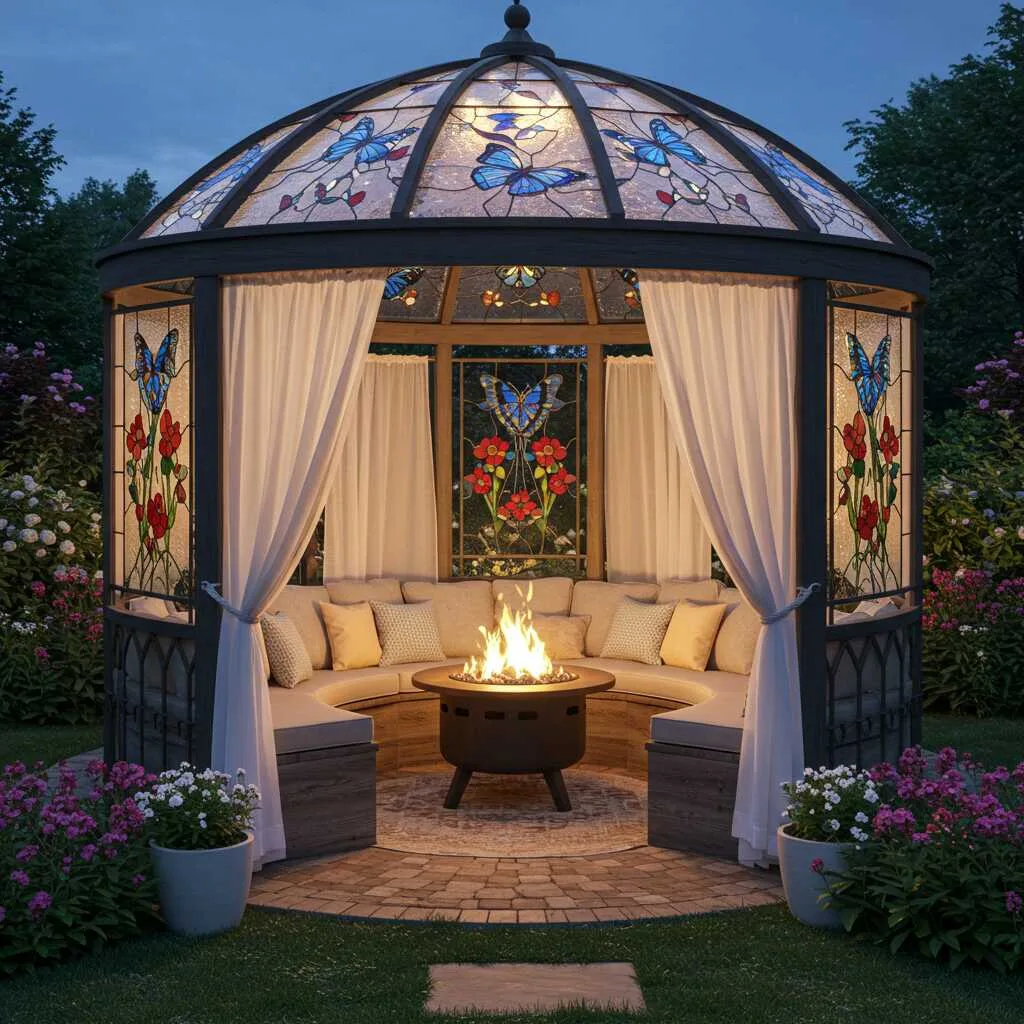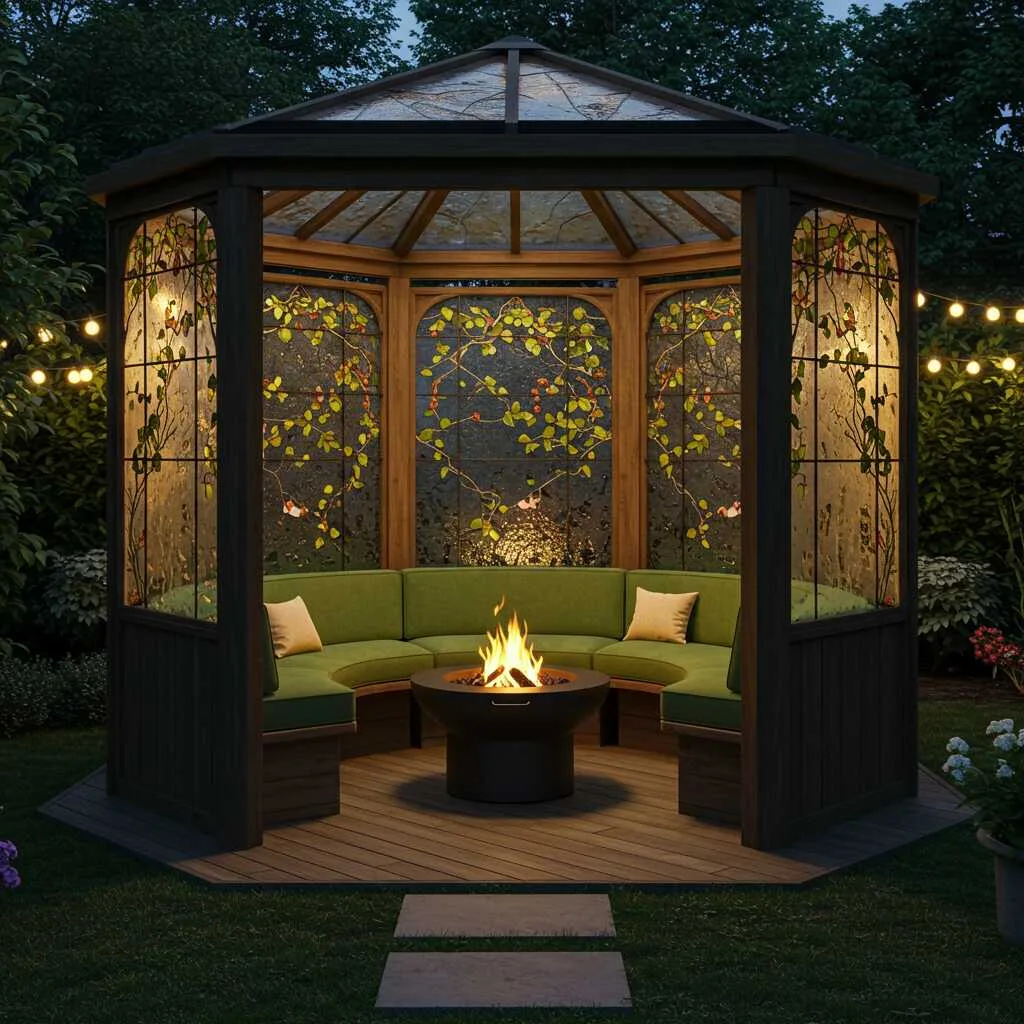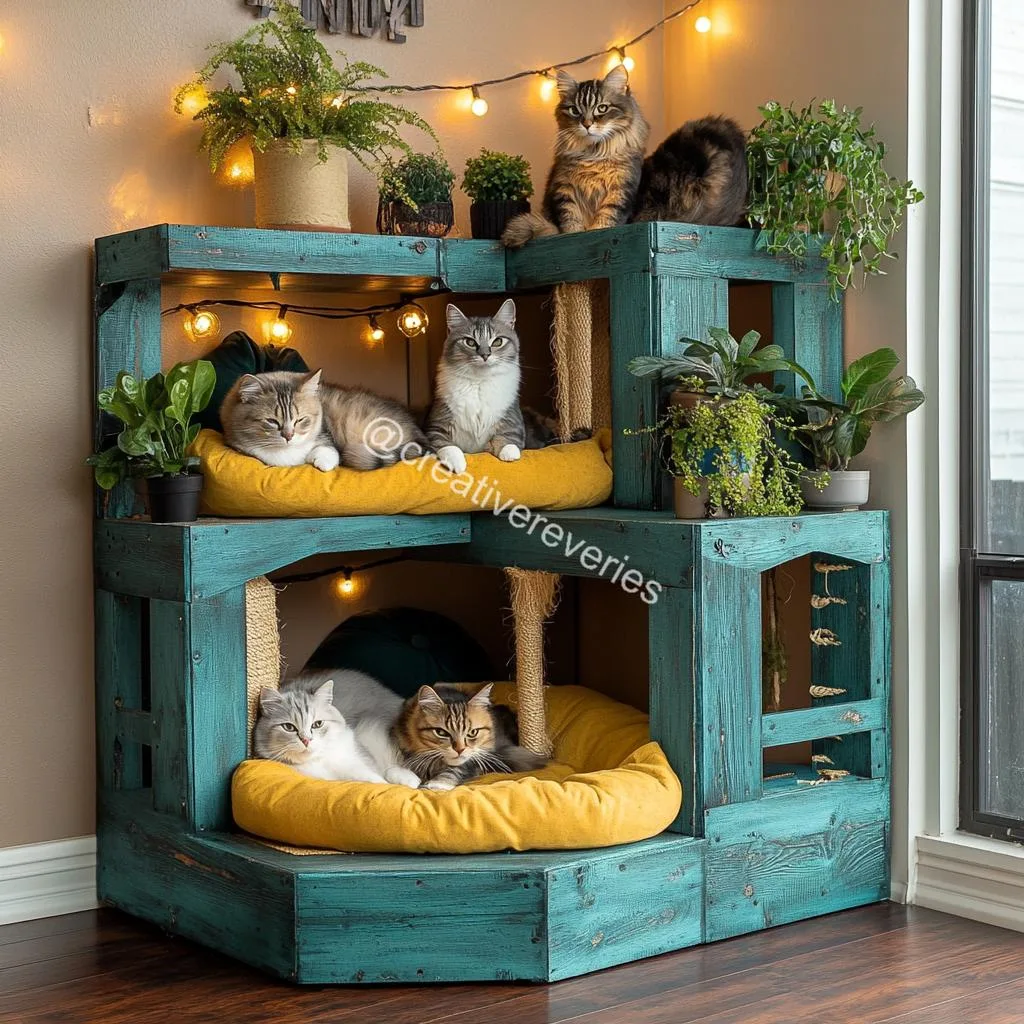The Enchantment of Stained Glass Gazebos
Throughout history, stained glass has been admired for its vibrant colors, artistic craftsmanship, and ability to transform light into breathtaking displays. While most commonly seen in grand cathedrals and historic buildings, stained glass has found a new and enchanting application in the world of outdoor architecture—stained glass gazebos.
A stained glass gazebo is more than just a structure; it is a masterpiece of design, color, and light that brings an ethereal quality to gardens, parks, and private estates. These gazebos merge the elegance of traditional craftsmanship with modern architectural ingenuity, offering a serene and visually stunning retreat.
In this article, we will explore:
- The history and artistic appeal of stained glass in architecture.
- Design elements and construction that make stained glass gazebos unique.
- Practical benefits and maintenance considerations.
- How to integrate a stained glass gazebo into different settings for maximum beauty and function.
Let’s step into the magical world of stained glass gazebos and discover why these exquisite structures are becoming a sought-after addition to outdoor spaces.
The Art and History Behind Stained Glass Gazebos
1. The Origins of Stained Glass in Architecture
Stained glass has been used in architecture for over a thousand years, dating back to medieval Europe. Originally used in churches and cathedrals, stained glass windows depicted religious stories, historical events, and nature-inspired designs.
a. The Role of Stained Glass in Historic Buildings
- Created a spiritual and awe-inspiring atmosphere.
- Allowed natural light to filter through, casting colorful, shifting patterns inside buildings.
- Showcased the artistic and technical skills of medieval glassmakers.

b. Evolution of Stained Glass in Modern Architecture
- Today, stained glass is no longer limited to religious buildings.
- It is used in homes, public buildings, and outdoor structures like gazebos.
- Modern techniques allow for intricate designs, durable glass, and UV protection, making stained glass a functional and decorative element.
2. The Rise of Stained Glass Gazebos
Over the years, architects and designers have explored creative ways to integrate stained glass into outdoor structures. The stained glass gazebo emerged as a unique blend of art, light, and architecture, offering an enchanting focal point in gardens, parks, and estates.
- Inspired by Victorian, Art Nouveau, and Gothic architectural styles.
- Brings the beauty of stained glass outdoors, where sunlight enhances its radiance.
- Creates a dreamlike atmosphere, perfect for relaxation, meditation, and special occasions.
Design Elements of Stained Glass Gazebos
3. The Structure: A Harmonious Blend of Strength and Beauty
A stained glass gazebo is designed to be both structurally sound and visually stunning. The materials used in its construction ensure durability while allowing light to pass through in dazzling patterns.
a. Frame Materials
To support the delicate glass panels, the gazebo’s frame must be made from strong, weather-resistant materials:
- Wrought Iron – Classic and ornate, perfect for vintage and Gothic-inspired designs.
- Wood – Creates a warm and natural aesthetic, complementing garden settings.
- Aluminum or Steel – Provides a modern touch with high durability and low maintenance.
b. Roof and Wall Designs
Stained glass can be incorporated into different parts of the gazebo:
- Roof panels – Creates a kaleidoscope effect as sunlight filters through.
- Side panels or windows – Adds privacy and artistic beauty.
- Door or entrance accents – Enhances the elegance of the structure.

4. The Stained Glass Patterns and Colors
The beauty of a stained glass gazebo lies in its intricate designs and color combinations. Some of the most popular stained glass themes include:
a. Nature-Inspired Motifs
- Floral patterns (roses, vines, and lilies) create a romantic ambiance.
- Butterflies, birds, and dragonflies add a whimsical touch.
- Tree branches and leaves blend harmoniously with garden settings.
b. Geometric and Abstract Designs
- Art Deco and Art Nouveau patterns offer a timeless elegance.
- Abstract shapes and symmetrical designs create a modern aesthetic.
c. Mythological and Fantasy Themes
- Fairy tale-inspired designs bring an element of magic.
- Celestial motifs (moons, stars, and suns) enhance nighttime beauty.
5. Lighting Effects and Sunlight Play
One of the most captivating aspects of a stained glass gazebo is how it interacts with sunlight.
- Morning Light: Soft and diffused colors create a gentle and calming effect.
- Afternoon Sun: Stronger rays enhance the brilliance and contrast of the colors.
- Evening Glow: Artificial lighting inside the gazebo can create a stunning illuminated effect at night.
Practical Benefits and Maintenance of Stained Glass Gazebos
6. Functional Benefits Beyond Beauty
A stained glass gazebo is not just about aesthetics—it also provides practical benefits:
- Shade and Protection: Offers relief from direct sunlight while still allowing light to pass through.
- Privacy: The stained glass panels act as decorative screens, giving a sense of seclusion.
- Weather Resistance: Properly built gazebos withstand rain, wind, and seasonal changes.

7. Maintenance and Care
To keep a stained glass gazebo in pristine condition, regular maintenance is essential.
a. Cleaning the Stained Glass Panels
- Use a soft cloth and mild soap to clean dust and dirt.
- Avoid harsh chemicals that may damage the glass or lead.
- Check for cracks or loose pieces and repair them promptly.
b. Maintaining the Frame
- Wooden frames require sealing or painting every few years.
- Metal frames should be rust-proofed and repainted when necessary.
- Ensure structural stability by checking for weak joints or loose connections.
How to Integrate a Stained Glass Gazebo into Your Outdoor Space
8. Choosing the Perfect Location
The placement of your stained glass gazebo plays a crucial role in its visual impact.
- Garden Setting: Surround with flowers, vines, and pathways for a fairy tale atmosphere.
- Lakeside or Riverside: Reflects beautifully on water, enhancing its charm.
- Patio or Courtyard: Adds an elegant touch to entertainment spaces.
9. Customization and Personalization
Many homeowners and designers choose to customize their stained glass gazebos to reflect personal taste.
- Monogrammed or family crest designs for a personal touch.
- Seasonal or holiday-themed stained glass panels for year-round beauty.
- Integrated seating, lighting, or water features to enhance functionality.
A Timeless Architectural Marvel
A stained glass gazebo is more than just an outdoor structure—it is a work of art that transforms light into a breathtaking display of color and beauty. Whether placed in a garden, park, or private estate, it serves as a sanctuary of peace, inspiration, and visual delight.
With intricate designs, artistic craftsmanship, and timeless elegance, stained glass gazebos stand as testaments to human creativity and appreciation for beauty. If you’re looking to add a touch of enchantment to your outdoor space, a stained glass gazebo is a perfect investment that will continue to captivate for generations.
Let the light shine through and bring magic to your world with a stained glass gazebo! 🌿✨🏡








